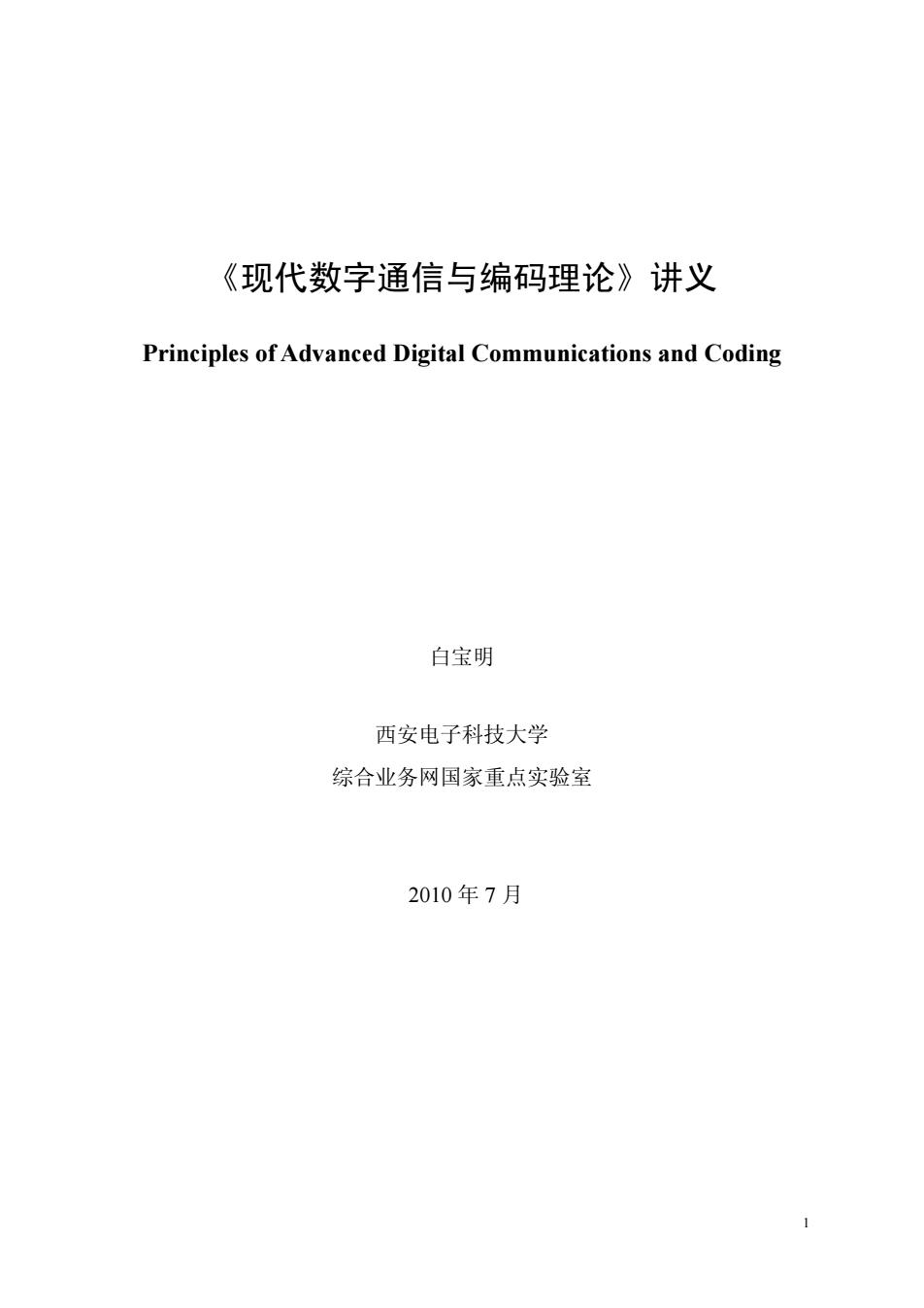
《现代数字通信与编码理论》讲义 Principles of Advanced Digital Communications and Coding 白宝明 西安电子科技大学 综合业务网国家重点实验室 2010年7月 1
1 《现代数字通信与编码理论》讲义 Principles of Advanced Digital Communications and Coding 白宝明 西安电子科技大学 综合业务网国家重点实验室 2010 年 7 月
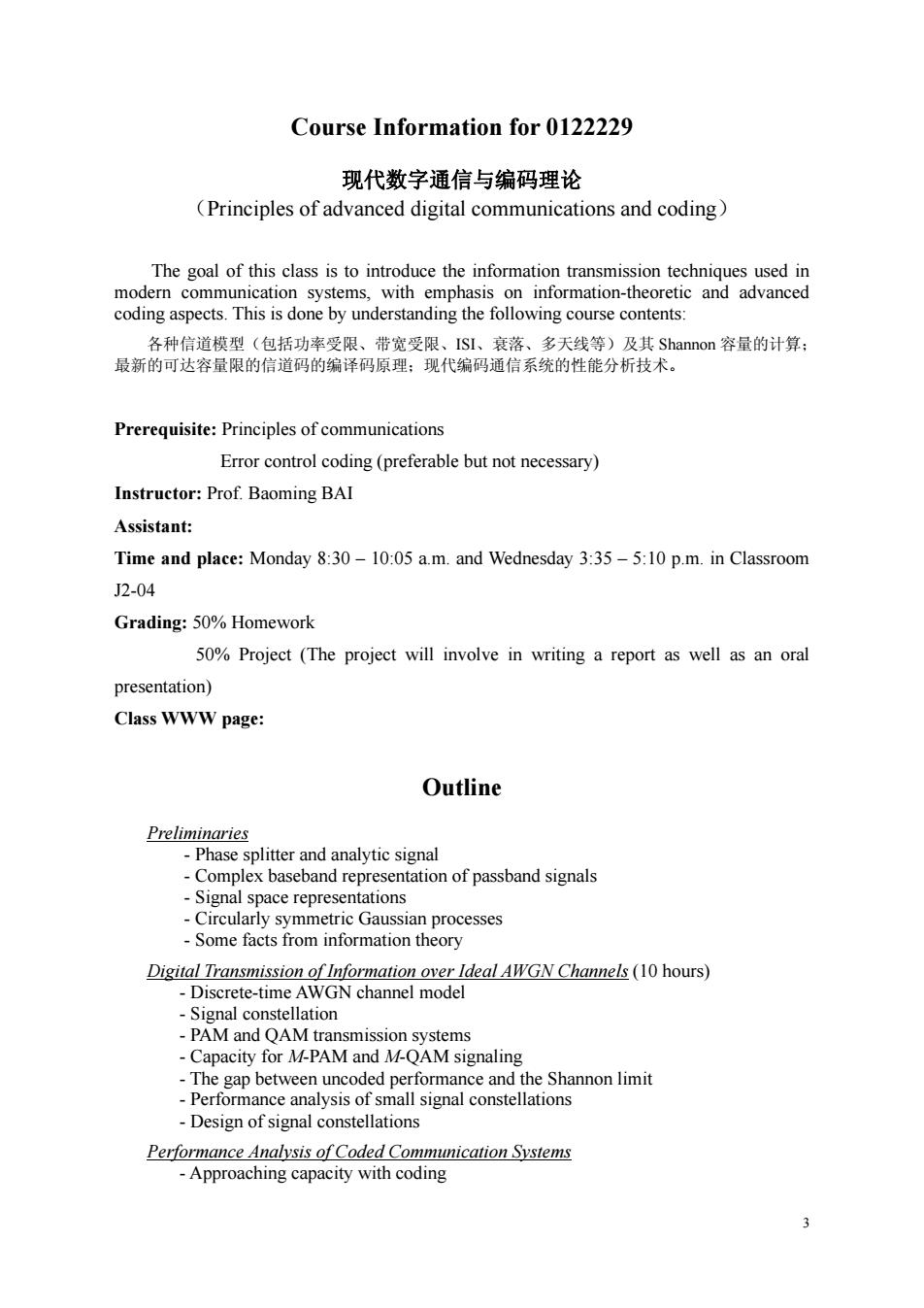
Course Information for 0122229 现代数字通信与编码理论 (Principles of advanced digital communications and coding) The goal of this class is to introduce the information transmission techniques used in modern cor mmun with e advanced 各种信道模型(包括功率受限、带宽受限、ISl、衰落、多天线等)及其Shannon容量的计算: 最新的可达容量限的信道码的编译码原理;现代编码通信系统的性能分析技术。 Prerequisite:Principles of communications Error control coding(preferable but not necessary) Instructor:Prof.Baoming BAI Assistant: Time and place:Monday 8:30-10:05 am.and Wednesday 3:35-5:10 p.m.in Classroom 2.04 Grading:50%Homework 50%Project (The project will involve in writing a report as well as an oral presentation) Class WWW page: Outline Preliminaries -Phase splitter and analytic signal -Complex baseband representation of passband signals -Signal space representations ric Gaussian processes Signal constellation PAM and QAM transmission systems Capacity for M-PAM and M-QAM signaling -The gap between uncoded performance and the Shannon limit -Performance analysis of small signal constellations -Design of signal constellations Performance Analysis of Coded Commuication Systems -Approac ing capacity with coding
3 Course Information for 0122229 现代数字通信与编码理论 (Principles of advanced digital communications and coding) The goal of this class is to introduce the information transmission techniques used in modern communication systems, with emphasis on information-theoretic and advanced coding aspects. This is done by understanding the following course contents: 各种信道模型(包括功率受限、带宽受限、ISI、衰落、多天线等)及其 Shannon 容量的计算; 最新的可达容量限的信道码的编译码原理;现代编码通信系统的性能分析技术。 Prerequisite: Principles of communications Error control coding (preferable but not necessary) Instructor: Prof. Baoming BAI Assistant: Time and place: Monday 8:30 – 10:05 a.m. and Wednesday 3:35 – 5:10 p.m. in Classroom J2-04 Grading: 50% Homework 50% Project (The project will involve in writing a report as well as an oral presentation) Class WWW page: Outline Preliminaries - Phase splitter and analytic signal - Complex baseband representation of passband signals - Signal space representations - Circularly symmetric Gaussian processes - Some facts from information theory Digital Transmission of Information over Ideal AWGN Channels (10 hours) - Discrete-time AWGN channel model - Signal constellation - PAM and QAM transmission systems - Capacity for M-PAM and M-QAM signaling - The gap between uncoded performance and the Shannon limit - Performance analysis of small signal constellations - Design of signal constellations Performance Analysis of Coded Communication Systems - Approaching capacity with coding
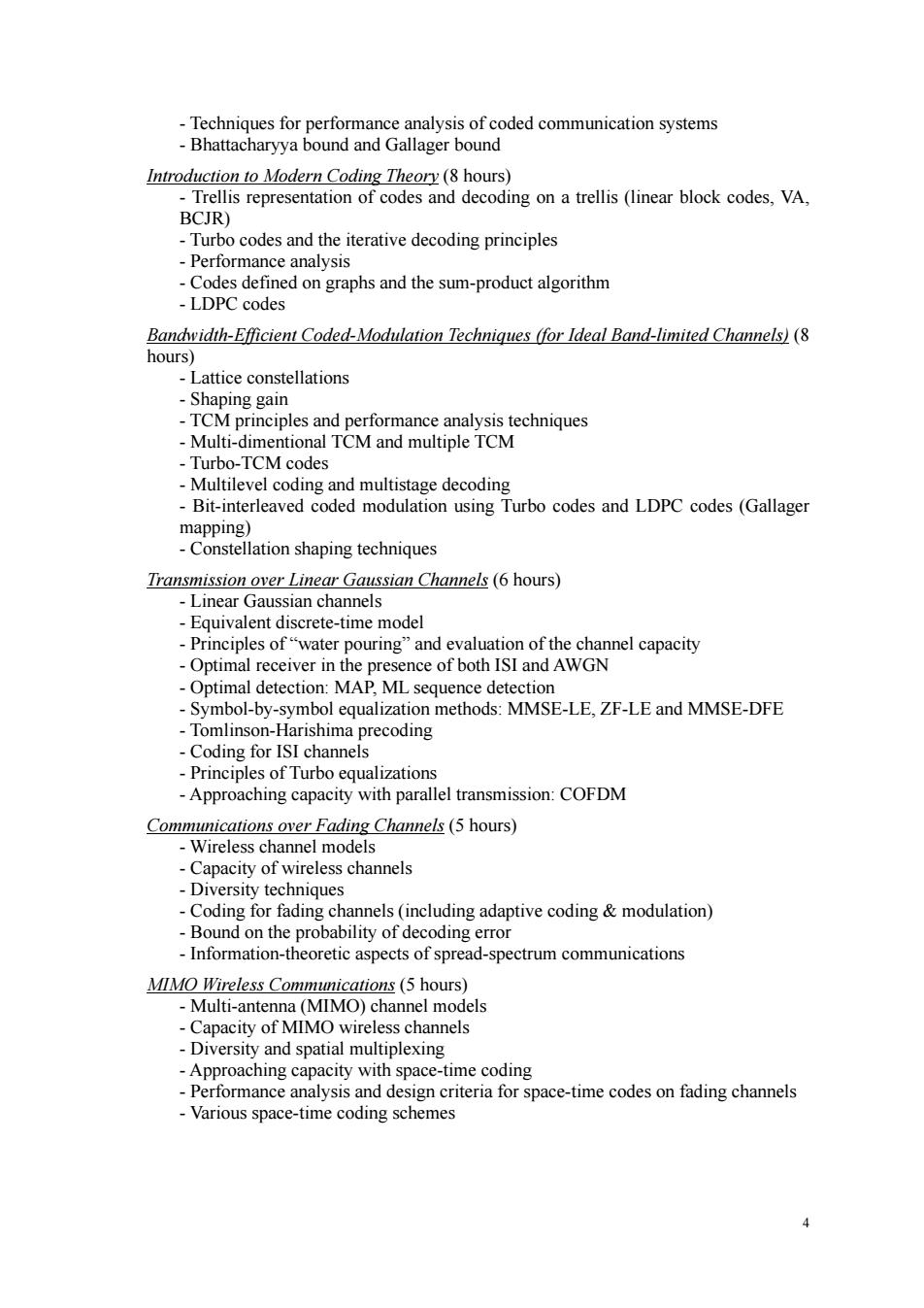
-Techniques for performance analysis of coded communication systems -Bhattacharyya bound and Gallager bound Introduction to Modern Coding Theory (8 hours) Trellis representation of codes and decoding on a trellis(linear block codes,VA. BCJR) codes and the iterative decoding principles D nce analysis -LDP de ed on graphs and the sum-product algorithm es Bandvidth-Efficient Coded-Modulation Techniques (for Ideal Band-limited Channels)(8 hours) -Lattice constellations Shaping gain -TCM principles and performance analysis techniques Multi-dimentional TCM and multiple TCM -TCM codes ultilevel cod age decoding teeaed codedmodulousin Turbo codes and LDPC codes (Gallager ng a pping llation shaping techniques Transmission over linear gaussian channels (6 hours) -Iinear Gaussian channels -Equivalent discrete-time model -Principles of"water pouring"and evaluation of the channel capacity -Optimal receiver in the presence of both ISI and AWGN Optimal detection:MAP,ML sequence detection Symbol-by-symbol equalization methods:MMSE-LE,ZF-LE and MMSE-DFE Tomlinson-H arishima precoding Coding for ISI channels Principl s of Turbo equalization -Approaching capacity with parallel transmission:COFDM Comn over Fading Channels(5 hours) nel r -Capacity of wireless channels -Diversity techniques -Coding for fading channels(including adaptive coding&modulation) -Bound on the probability of decoding error -Information-theoretic aspects of spread-spectrum communications unications(5 hours) ntenna el models I s cn and spatia I mu plexing ng a ce-t Ce- or space-time codes on fading channels coding sch 4
4 - Techniques for performance analysis of coded communication systems - Bhattacharyya bound and Gallager bound Introduction to Modern Coding Theory (8 hours) - Trellis representation of codes and decoding on a trellis (linear block codes, VA, BCJR) - Turbo codes and the iterative decoding principles - Performance analysis - Codes defined on graphs and the sum-product algorithm - LDPC codes Bandwidth-Efficient Coded-Modulation Techniques (for Ideal Band-limited Channels) (8 hours) - Lattice constellations - Shaping gain - TCM principles and performance analysis techniques - Multi-dimentional TCM and multiple TCM - Turbo-TCM codes - Multilevel coding and multistage decoding - Bit-interleaved coded modulation using Turbo codes and LDPC codes (Gallager mapping) - Constellation shaping techniques Transmission over Linear Gaussian Channels (6 hours) - Linear Gaussian channels - Equivalent discrete-time model - Principles of “water pouring” and evaluation of the channel capacity - Optimal receiver in the presence of both ISI and AWGN - Optimal detection: MAP, ML sequence detection - Symbol-by-symbol equalization methods: MMSE-LE, ZF-LE and MMSE-DFE - Tomlinson-Harishima precoding - Coding for ISI channels - Principles of Turbo equalizations - Approaching capacity with parallel transmission: COFDM Communications over Fading Channels (5 hours) - Wireless channel models - Capacity of wireless channels - Diversity techniques - Coding for fading channels (including adaptive coding & modulation) - Bound on the probability of decoding error - Information-theoretic aspects of spread-spectrum communications MIMO Wireless Communications (5 hours) - Multi-antenna (MIMO) channel models - Capacity of MIMO wireless channels - Diversity and spatial multiplexing - Approaching capacity with space-time coding - Performance analysis and design criteria for space-time codes on fading channels - Various space-time coding schemes
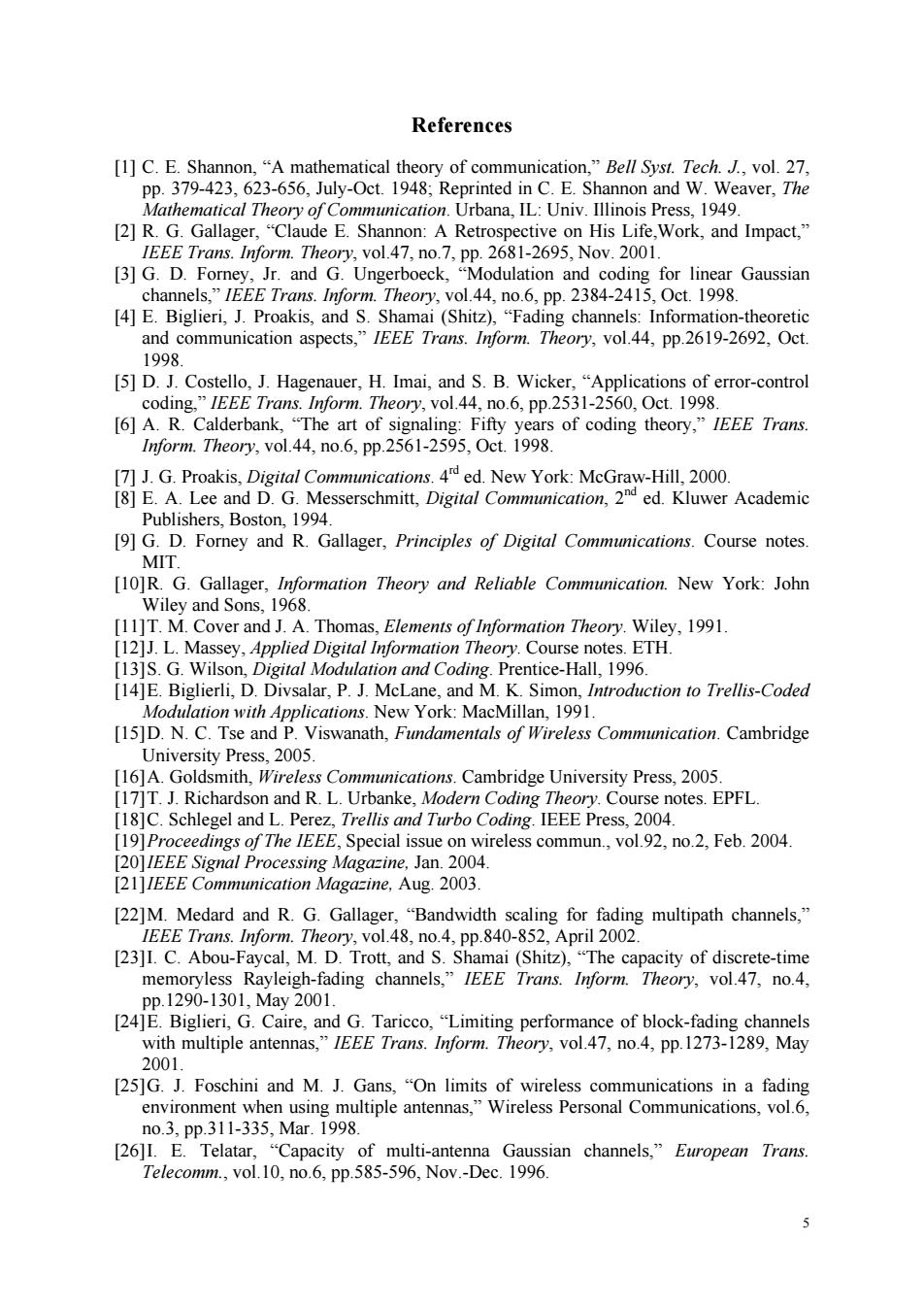
References [1]C.E.Shannon,"A mathematical theory of communication,"Bell Syst.Tech.J.,vol.27. pp.379-423,623-656,July-Oct.1948;Reprinted in C.E.Shannon and W.Weaver,The athematical Theory of Communication.Urbana,IL:Univ.Illinois Press,1949. “Claude E.Shannon: A Retrospective on His Life,Work,and Impact," ran ory,vol.4 209D, 31G.D. and line r Gaussian I P m. ol44, chann nd c aspe cts,”EEE Trans. rm.Theory, ol 44 pp.2619-26920 1998 [5]D.J.Costello,J.Hagenauer,H.Imai,and S.B.Wicker coding: [6]A.R.Calderbank."The art of signaling:Fifty yea 0l4,06Pp25312500L198cc0ntoy Inform.Theory,vol.44,no.6,pp.2561-2595,Oct.1998. 肉9em&ma学ak2 ed.Kluwer Academic shers,Boston 99 [9]G D.Fomey and R.Gallager,Principles of Digital Communications.Course notes [1O]R G Gallager, ormation Theory and Reliable Communication.New York:Johr [12]J.L.Masse Course n s ETH 13]S.G.Wilson.Digital Modulation and Coding.Prentice-Hall,1996 [14]E.Biglierli,D.Divsalar,P.J.McLane,and M.K.Simon,Introduction to Trellis-Coded Modulation with Applications.New York:MacMillan,1991. [15]D.N.C.Tse and P.Viswanath,Fundamentals of Wireless Communication.Cambridge University Press,2005. [16]A.Goldsmith,Wireless Communications.Cambridge University Press,2005. 17]T.J.Richardson and R.L.Urbanke,Modern Coding Theory.Course notes.EPFL. 18]C.Schlegel and L.Pere Trellis and Turbo Coding.IEEE Press,2004. ireless commun.,vol.92,no.2,Feb.2004 Signa [22]M.Medard and R.G.Gallager,"Bandwidth scaling for fading multipath channels." vol.48.no.4. [23]I.C.Abou-Faycal,M.D.Trott,and S.Shamai (Shitz). m2Cpesyotdsem memoryless Rayleigh-fading channels,"IEEE Trans.Inform.Theory,vol.47,no.4. pp.1290-130L,May2001. [24JE.Biglieri,G.Caire,and G.Taricco,"Limiting performance of block-fading channels with multiple antennas,"IEEE Trans.Inform.Theory,vol.47,no.4,pp.1273-1289,May 2001 [25]G.J.Foschini and M.J.Gans,"On limits of wireless communications in a fading ltiple antennas,"Wireless Personal Communications,vol.6. elata mul sian channels,"European Trans 5
5 References [1] C. E. Shannon, “A mathematical theory of communication,” Bell Syst. Tech. J., vol. 27, pp. 379-423, 623-656, July-Oct. 1948; Reprinted in C. E. Shannon and W. Weaver, The Mathematical Theory of Communication. Urbana, IL: Univ. Illinois Press, 1949. [2] R. G. Gallager, “Claude E. Shannon: A Retrospective on His Life,Work, and Impact,” IEEE Trans. Inform. Theory, vol.47, no.7, pp. 2681-2695, Nov. 2001. [3] G. D. Forney, Jr. and G. Ungerboeck, “Modulation and coding for linear Gaussian channels,” IEEE Trans. Inform. Theory, vol.44, no.6, pp. 2384-2415, Oct. 1998. [4] E. Biglieri, J. Proakis, and S. Shamai (Shitz), “Fading channels: Information-theoretic and communication aspects,” IEEE Trans. Inform. Theory, vol.44, pp.2619-2692, Oct. 1998. [5] D. J. Costello, J. Hagenauer, H. Imai, and S. B. Wicker, “Applications of error-control coding,” IEEE Trans. Inform. Theory, vol.44, no.6, pp.2531-2560, Oct. 1998. [6] A. R. Calderbank, “The art of signaling: Fifty years of coding theory,” IEEE Trans. Inform. Theory, vol.44, no.6, pp.2561-2595, Oct. 1998. [7] J. G. Proakis, Digital Communications. 4rd ed. New York: McGraw-Hill, 2000. [8] E. A. Lee and D. G. Messerschmitt, Digital Communication, 2nd ed. Kluwer Academic Publishers, Boston, 1994. [9] G. D. Forney and R. Gallager, Principles of Digital Communications. Course notes. MIT. [10]R. G. Gallager, Information Theory and Reliable Communication. New York: John Wiley and Sons, 1968. [11]T. M. Cover and J. A. Thomas, Elements of Information Theory. Wiley, 1991. [12]J. L. Massey, Applied Digital Information Theory. Course notes. ETH. [13]S. G. Wilson, Digital Modulation and Coding. Prentice-Hall, 1996. [14]E. Biglierli, D. Divsalar, P. J. McLane, and M. K. Simon, Introduction to Trellis-Coded Modulation with Applications. New York: MacMillan, 1991. [15]D. N. C. Tse and P. Viswanath, Fundamentals of Wireless Communication. Cambridge University Press, 2005. [16]A. Goldsmith, Wireless Communications. Cambridge University Press, 2005. [17]T. J. Richardson and R. L. Urbanke, Modern Coding Theory. Course notes. EPFL. [18]C. Schlegel and L. Perez, Trellis and Turbo Coding. IEEE Press, 2004. [19]Proceedings of The IEEE, Special issue on wireless commun., vol.92, no.2, Feb. 2004. [20]IEEE Signal Processing Magazine, Jan. 2004. [21]IEEE Communication Magazine, Aug. 2003. [22]M. Medard and R. G. Gallager, “Bandwidth scaling for fading multipath channels,” IEEE Trans. Inform. Theory, vol.48, no.4, pp.840-852, April 2002. [23]I. C. Abou-Faycal, M. D. Trott, and S. Shamai (Shitz), “The capacity of discrete-time memoryless Rayleigh-fading channels,” IEEE Trans. Inform. Theory, vol.47, no.4, pp.1290-1301, May 2001. [24]E. Biglieri, G. Caire, and G. Taricco, “Limiting performance of block-fading channels with multiple antennas,” IEEE Trans. Inform. Theory, vol.47, no.4, pp.1273-1289, May 2001. [25]G. J. Foschini and M. J. Gans, “On limits of wireless communications in a fading environment when using multiple antennas,” Wireless Personal Communications, vol.6, no.3, pp.311-335, Mar. 1998. [26]I. E. Telatar, “Capacity of multi-antenna Gaussian channels,” European Trans. Telecomm., vol.10, no.6, pp.585-596, Nov.-Dec. 1996
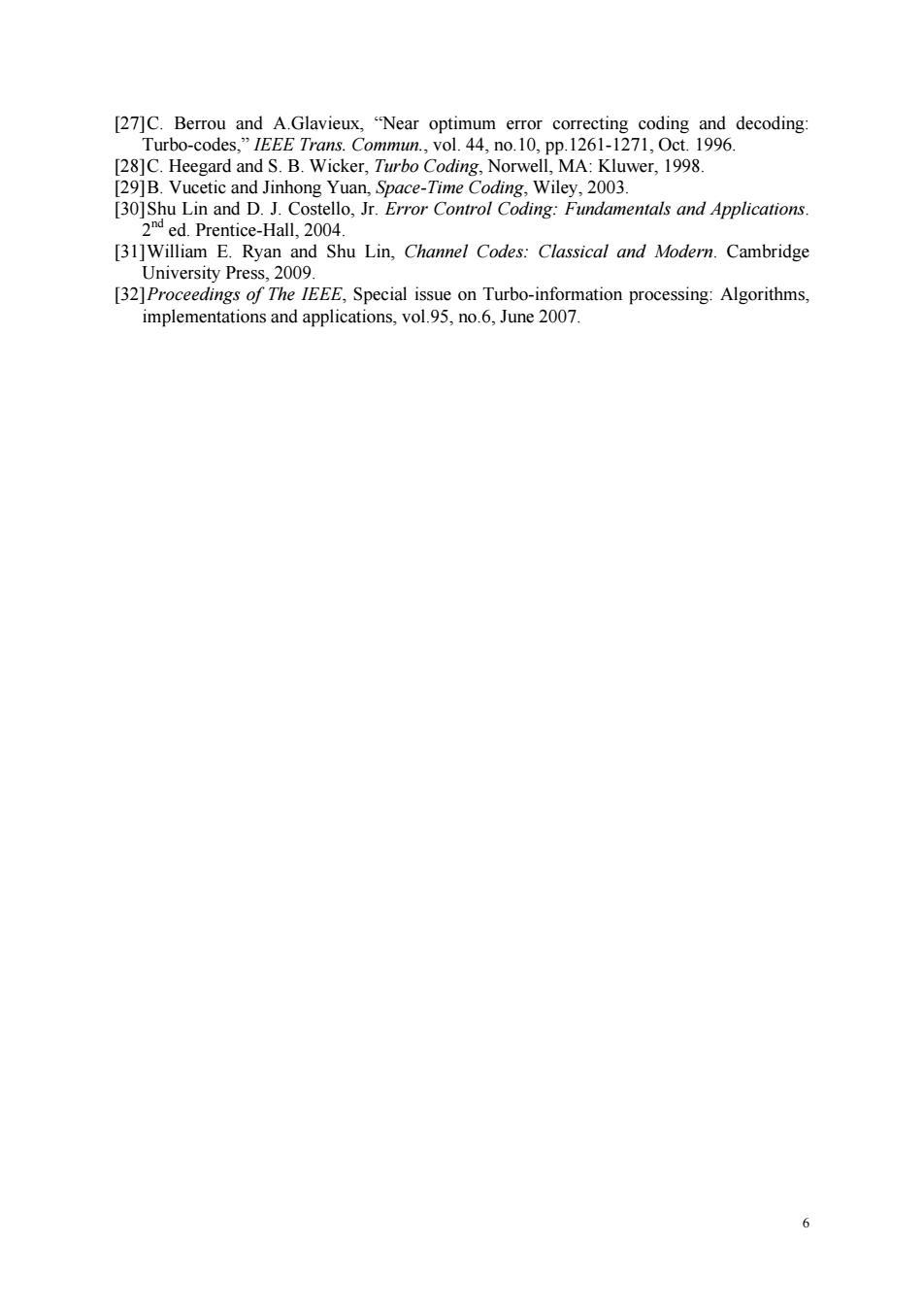
[27]C.Berrou and A.Glavieux,"Near optimum error correcting coding and decoding Turbo-codes,"IEEE Trans.Commun.,vol.44,no.10,pp.1261-1271,Oct.1996. [28]C.Heegard and S.B.Wicker,Turbo Coding,Norwell,MA:Kluwer,1998. 29]B.Vucetic and Jinhong Yuan,Space-Time Coding,Wiley,2003. 30]Shu Lin and D.J.Costello,Jr.Error Control Coding:Fundamentals and Applications. .Prentice-Hall,2004 [31]William E. niversity Pres 32]Proceed issue n Turb-information prcesing Algorithms implementations and applications,vol95,n,June 2007 6
6 [27]C. Berrou and A.Glavieux, “Near optimum error correcting coding and decoding: Turbo-codes,” IEEE Trans. Commun., vol. 44, no.10, pp.1261-1271, Oct. 1996. [28]C. Heegard and S. B. Wicker, Turbo Coding, Norwell, MA: Kluwer, 1998. [29]B. Vucetic and Jinhong Yuan, Space-Time Coding, Wiley, 2003. [30]Shu Lin and D. J. Costello, Jr. Error Control Coding: Fundamentals and Applications. 2nd ed. Prentice-Hall, 2004. [31]William E. Ryan and Shu Lin, Channel Codes: Classical and Modern. Cambridge University Press, 2009. [32]Proceedings of The IEEE, Special issue on Turbo-information processing: Algorithms, implementations and applications, vol.95, no.6, June 2007